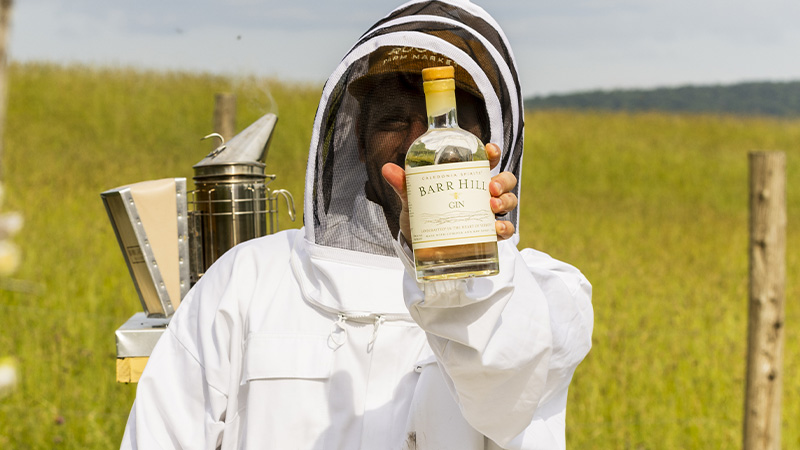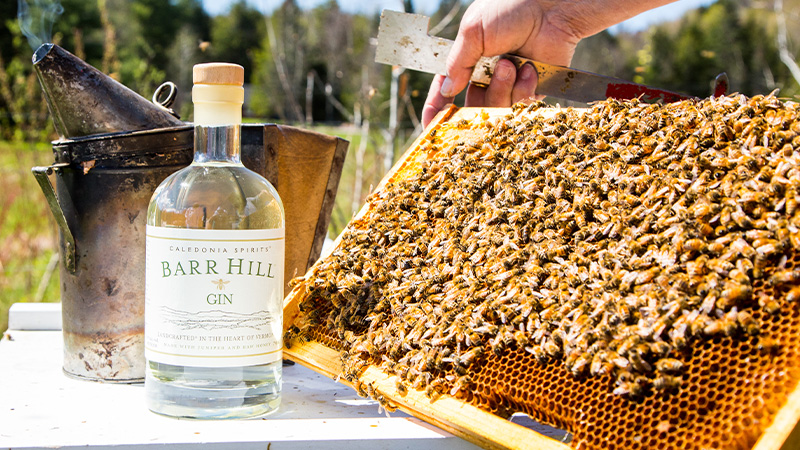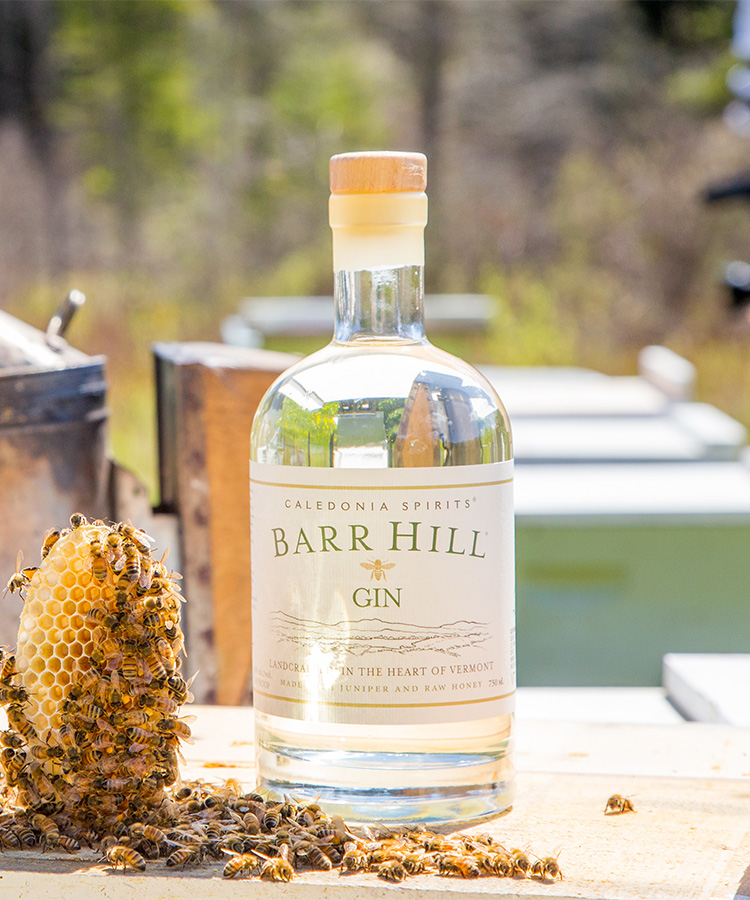
There are so many different bottles of gin on liquor store shelves these days, and most are flavored with a wide range of botanicals. While juniper is always at the forefront, pretty much anything else you can think of can play a supporting role, and many brands try to capture a sense of terroir through a specific, hand-picked blend of citrus, spices, and herbs. Barr Hill Gin, however, takes this concept in the opposite direction, using just two ingredients to create its unique palate — juniper and regional raw honey.
Barr Hill Gin, produced by Caledonia Spirits in Montpelier, Vt., was created by distiller Ryan Christiansen and beekeeper Todd Hardie in 2011. Their concept was simple but logical: to use raw honey as the distinguishing ingredient, resulting in a spirit infused with a wide array of flavors. That’s because the bees that make the honey spend their life pollinating countless wildflowers, and while flitting from petal to petal, they collect a range of botanical flavors. The proof is in the spirit, which has a complex palate despite its simplicity — or perhaps because of it — with a subtle juniper presence that complements notes of wildflower, nectar, and spice.

Given the importance of bees to Barr Hill Spirits, and indeed the environment, it makes sense that the distillery keeps sustainability front of mind in its philosophy and practices. To that end, in 2019 the team built a new distillery that is powered by sustainability, both literally and as an ethos. The building was built on a reclaimed brownfield site, repurposing previously neglected land as opposed to breaking ground on a brand-new site. The distillery runs on 100 percent carbon-neutral energy, and more than three-quarters of that power comes from renewable resources instead of fossil fuels. Nothing is wasted — the spent stillage goes to a biodigester where it is converted into power for the nearby town, the heat created by the distillery is reclaimed and reused, and even the bottles are made from 30 percent recycled glass.
But it’s not just the effort to reduce its carbon footprint that makes Barr Hill Gin stand out. Caledonia Spirits is also conscious of the impact that climate change is having on the bees that are so important to the gin, as well as many of the food and drinks we rely on — one out of every three bites of food depends on pollinators. To that end, the distillery created the annual Bee’s Knees Week (learn more at beeskneesweek.com) in 2017 to raise awareness for and help support bees and other pollinators, whose populations are struggling due to habitat loss, climate change, and colony collapse disorder. To date, this initiative has helped to create more than 23 acres of new pollinator habitat, a significant step in helping to restore the environment and support the continued existence of this crucial part of our biosphere, which plays a much bigger part in the ecosystem than just making gin taste good.

Barr Hill Gin’s latest effort to support pollinators is a Bee’s Knees cocktail competition called The Royal Jelly. It’s named after the nutrient-rich jelly that bees feed to their babies and, most importantly, to the queen. Royal jelly even helps to extend her life from an average of four to five months to about four to five years.
Bartenders from all across the Northeast participated in this new competition, using Barr Hill Gin to create their own version of the classic Bee’s Knees cocktail. Eight semifinalists won the chance to compete in person at the Barr Hill distillery and cocktail bar in Vermont, and the top four moved on to the final round. Among other prizes, the four finalists each earned a pollinator habitat offset equivalent to the square footage of their bar or restaurant, along with one winner to be crowned — what else — the Royal Jelly.
The semifinalists in the Royal Jelly competition came up with some innovative variations on the Bee’s Knees cocktail, a Prohibition-era drink that is typically made using just gin, lemon juice, and honey.
- Hector Guzman-Roman, a Puerto Rico native who now calls Maine home, added a smoky Mexican twist to his version by incorporating mezcal into the drink, along with modern touches like beach rose hip and honey meringue foam.
- Jack O’Brien, also from Maine, chose to incorporate a savory element by using black garlic vodka and toasted sesame orgeat.
- Portland, Maine bartender Olivia Watts added Barr Hill Tom Cat Gin and honey pistachio orgeat to her take on this classic.
- Madison Drain, from Providence, R.I., came up with a Japanese-influenced version that has toragashi, shochu, and kombu in the mix.
- NYC’s Shintaro Eleazor Tozzo showed the skills he has honed in the culinary world with the Bee Bop using brown butter-washed Barr Hill gin, honey, grapefruit, egg white, Himalayan sea salt and a caramel tuile for garnish.
- Vermont-based bartender Jamie Pessoa Montairo came up with a tropical variation called the Mai Hive, a sort of Bee’s Knees-Mai Tai hybrid with honey, orgeat, walnut bitters, and pineapple-infused Tom Cat Gin.
- Katie Thompson, also bartending in Vermont, took us through a garden romp with her floral, cucumber-y Garden Buzz that’s garnished with a unique lemon Jell-O shot made with Tom Cat.
- Another Vermonter, Lauren Simmons, played off the flavors of citrus and carrots for Bugs Hunny.
The final competition took place on Aug. 25, 2024 at the distillery’s James Beard-nominated bar in Montpelier, Vt. The winners were (drumroll please!):
- Royal Jelly Winner: Shintaro Eleazor Tozzo of Bar Moga
- Second Place and People’s Choice: Lauren Simmons of Frankie’s
- Third Place: Madison Drain of Tiny Bar
The real winner was Barr Hill’s pollinator pals, the bees that provide the crucial ingredient that is the core of this uniquely delicious and sustainable Vermont gin.
This article is sponsored by Barr Hill Gin.
